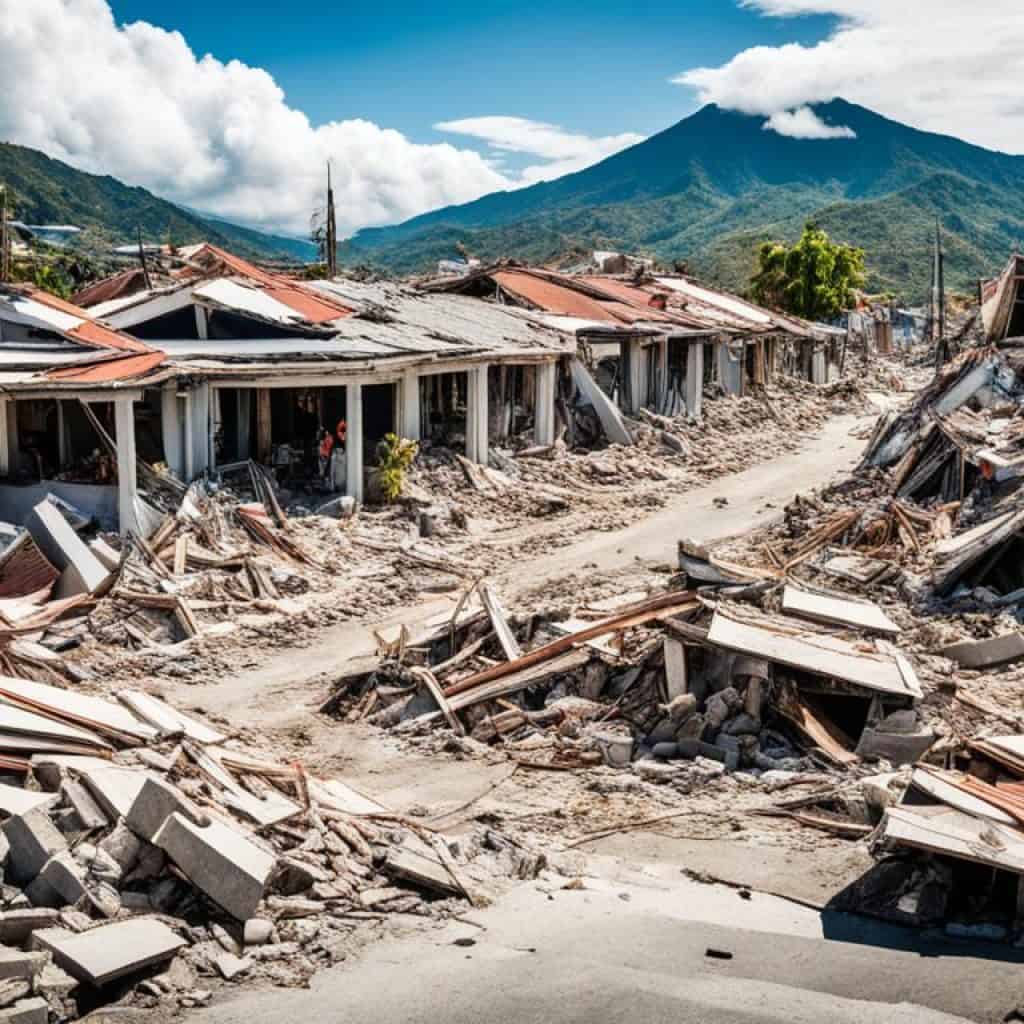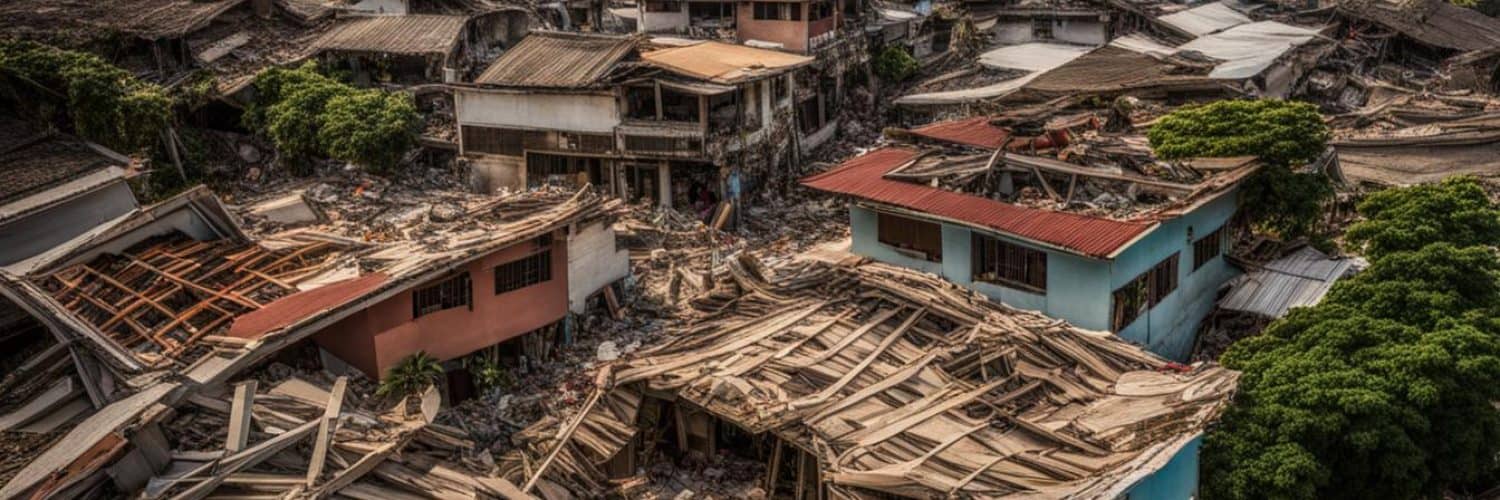Have you ever wondered what the strongest earthquake in the Philippines was? How powerful was it and what were the consequences? In a country known for its seismic activity, the Philippines has a long history of devastating earthquakes. But among them all, one earthquake stands out as the strongest ever recorded. So, what was it?
Key Takeaways:
- The Philippines has a long history of devastating earthquakes, making it one of the most earthquake-prone countries in the world.
- The strongest recorded earthquake in the Philippines had a magnitude of ______ and caused widespread destruction.
- Understanding the power and consequences of past earthquakes is crucial for preparedness and resilience in the face of future seismic events.
- Efforts are being made to improve building codes, retrofit infrastructure, and enhance the response capacity of government agencies in the Philippines.
- Resilience and community support play a vital role in rebuilding and moving forward after a major earthquake.
Potential Impacts of a Major Earthquake in Metro Manila
A magnitude 7.2 earthquake on the West Valley Fault could have catastrophic consequences for Metro Manila, resulting in significant loss of life, economic damage, and severe disruption to key public services.
Impact and Fatalities
In the event of a major earthquake, it is estimated that up to 48,000 lives could be lost in Metro Manila alone. The densely populated urban area would be severely affected, with the potential for significant casualties.
Economic Losses
The economic impact of such an earthquake would be substantial, with an estimated $48 billion in losses. The destruction of infrastructure, businesses, and homes would result in a long and costly recovery process.
Urban Mobility
Metro Manila’s already congested transportation system would be greatly impacted by a major earthquake. Damage to roads, bridges, and transportation networks would severely impede movement throughout the city, making it challenging for emergency services to reach those in need and for residents to access essential goods and services.
Health System
The Metro Manila health system would face immense strain in the aftermath of a major earthquake. Hospitals and medical facilities may be damaged or overwhelmed, making it difficult to provide adequate care to the injured. Ensuring the resilience and accessibility of these critical healthcare institutions is vital for saving lives.
Lifeline Infrastructure
The earthquake would pose a significant threat to the lifeline infrastructure of Metro Manila. The water supply, energy distribution, and communication networks could all be severely damaged or disrupted, exacerbating the hardships faced by the affected population.
Ensuring Resilience
It is crucial for Metro Manila to prioritize earthquake preparedness, invest in building resilience, and implement strict building codes. By fortifying critical infrastructure, developing emergency response plans, and enhancing public awareness, the city can better handle the potential impacts of a major earthquake and protect the lives and livelihoods of its residents.
Visual representation of the potential impacts of a major earthquake in Metro Manila.
Accessibility Analysis and Road Damage
An accessibility analysis of Metro Manila reveals concerning findings regarding the potential impact of a major earthquake on the road network. It is estimated that over 7,000 km of roads, approximately 34% of the road network, could be affected by liquefaction and ground deformation.
Liquefaction, a phenomenon in which saturated soil temporarily loses strength due to seismic activity, and ground shaking are expected to cause significant damage to roadways. This damage poses a serious threat to the accessibility of critical public services, including hospitals and other essential facilities.
Access times to health facilities could increase by approximately 148% on average in Metro Manila, making it extremely challenging for people to receive the necessary medical care in the aftermath of a major earthquake.
| Effect | Statistics |
|---|---|
| Approximate road length affected | Over 7,000 km (34% of the road network) |
| Access time increase to health facilities | Approximately 148% on average |
These findings highlight the urgency of implementing mitigation measures to strengthen the road infrastructure in Metro Manila and ensure the timely transportation of emergency response teams, supplies, and aid to those in need.
“The impact of road damage caused by liquefaction and ground deformation can disrupt critical lifelines, hampering immediate assistance and hindering recovery efforts.”
– Metro Manila Disaster Risk Reduction and Management Council
A comprehensive plan for road resilience is vital to enhance accessibility and enable swift recovery in the face of a major earthquake. This includes prioritizing road repairs, implementing engineering solutions to mitigate liquefaction, and ensuring efficient communication and coordination among relevant authorities and agencies.
Preparing for “The Big One”
Earthquakes are a constant threat in the Philippines, and it is crucial to invest in earthquake preparedness and response systems to minimize their impacts. The Department of Public Works and Highways is leading the way in seismic risk reduction, particularly in Metro Manila, where the risk is especially high.
One of the key initiatives in earthquake preparedness is the Philippines Seismic Risk Reduction and Resilience Project. This project aims to strengthen the resilience of Metro Manila by retrofitting buildings, enhancing the preparedness and response capacity of government agencies, and improving emergency communication and information management.
The project focuses on upgrading 425 public buildings, including health facilities and schools, ensuring that they can withstand the seismic forces and continue to provide critical services during and after an earthquake. By retrofitting these buildings, the project is not only ensuring the safety of the occupants but also protecting the essential infrastructure that the community relies on.
Another crucial aspect of earthquake preparedness in Metro Manila is planning for transport and mobility restoration after a disaster. The project includes measures to ensure that the road network remains functional, allowing emergency services to reach affected areas quickly and efficiently.
The Department of Public Works and Highways recognizes the importance of emergency preparedness at both the individual and community levels. They work closely with local governments, communities, and stakeholders to raise awareness about earthquake preparedness and the necessary steps to take in case of an earthquake. This includes educating the public on evacuation routes, emergency supplies, and first-aid techniques.
“Earthquakes are inevitable, but their impact can be reduced through proper preparedness. By taking proactive measures and investing in earthquake resilience, we can protect lives and property in Metro Manila,” says Dr. Juanito G. Buan Jr., Secretary of the Department of Public Works and Highways.
The Philippines Seismic Risk Reduction and Resilience Project is a significant step forward in earthquake preparedness, and it serves as a model for other high-risk areas in the Philippines. By focusing on retrofitting buildings, enhancing government agencies’ preparedness and response capacity, and improving communication and information management, Metro Manila is better equipped to handle the challenges posed by a major earthquake.
| Initiative | Description |
|---|---|
| Retrofitting Public Buildings | Upgrading 425 public buildings, including health facilities and schools, to ensure their resiliency against earthquakes. |
| Enhancing Preparedness and Response Capacity | Strengthening government agencies’ capability to respond to earthquakes by conducting drills, training personnel, and establishing emergency protocols. |
| Improving Emergency Communication and Information Management | Enhancing the communication infrastructure and systems for effective dissemination of information and coordination during and after an earthquake. |
History of Earthquakes in the Philippines
The Philippines, situated along the Pacific Ocean’s “Ring of Fire” and intersected by five major fault lines, is no stranger to natural disasters. With a history marked by devastating earthquakes, the nation has endured immense destruction and loss.
One of the deadliest earthquakes in the Philippines occurred in 1990. The Luzon earthquake, measuring a magnitude of 7.8, claimed thousands of lives and left behind widespread devastation.
“The frequent seismic activity in the Philippines serves as a constant reminder of the ongoing danger faced by the population.”
The frequency of earthquake occurrences in the Philippines highlights the region’s high tectonic activity and vulnerability. The country experiences regular seismic events, reinforcing the importance of preparedness and resilience in the face of such risks.
“The history of earthquakes in the Philippines underscores the urgent need for comprehensive disaster management strategies to protect lives and safeguard infrastructure.”
To gain a deeper understanding of the impact of earthquakes in the region, let’s explore a table showcasing some of the deadliest earthquakes recorded in the history of the Philippines:
| Year | Location | Magnitude | Loss of Lives |
|---|---|---|---|
| 1990 | Luzon | 7.8 | Estimated 1,600 fatalities |
| 1976 | Mindanao | 7.9 | Greater than 8,000 deaths |
| 1948 | Manila | 7.3 | Estimated 1,200 fatalities |
As evident from the table, these earthquakes caused significant loss of lives and left a lasting impact on the affected communities.
Understanding the history of earthquakes in the Philippines is crucial for implementing effective disaster management strategies and building a more resilient future.

Lessons from Past Earthquakes: Building Codes and Disaster Readiness
The devastating 1990 Luzon earthquake serves as a powerful reminder of the importance of earthquake preparedness in the Philippines. Lessons learned from this tragic event have shaped the country’s approach to building codes and disaster readiness.
Dr. Renato Solidum, a renowned expert from the Philippine Institute of Volcanology and Seismology, has emphasized the critical role of proper response, hazard simulation, implementation of building codes, and careful land use planning in reducing the impact of earthquakes.
The implementation of strict building codes has been instrumental in enhancing the structural integrity of buildings and ensuring their resilience to seismic activity. These codes dictate specific requirements for construction, such as the use of reinforced materials and techniques to safeguard against earthquake forces.
Additionally, disaster readiness measures have been continuously strengthened to improve emergency response and mitigate the potential consequences of future earthquakes. These efforts include comprehensive risk assessment, early warning systems, evacuation plans, and public education campaigns.
Dr. Solidum has highlighted the importance of proactive measures, stating, “By understanding the risks associated with earthquakes and implementing appropriate strategies, we can significantly reduce the loss of lives and property in the Philippines.”
As a result of these valuable lessons, the Philippines has made significant progress in earthquake preparedness. However, there is still room for continuous improvement in both policy implementation and public awareness.
The Impact of the Powerful 7.6-Magnitude Earthquake
A powerful 7.6-magnitude earthquake struck the eastern parts of the Philippines, causing widespread panic and triggering tsunami warnings. The seismic event sent shockwaves through the affected regions, leaving a trail of destruction in its wake.
While there were no immediate reports of injuries, property damage and power failures were reported. The earthquake shook buildings and infrastructure, leaving communities without electricity and essential services. The resilience of the Filipino people was tested as they faced the challenges posed by this natural disaster.
In response to the earthquake, authorities quickly issued tsunami warnings, prompting coastal evacuations in vulnerable areas. The potential for a tsunami added to the fear and urgency experienced by local residents.
Assessment of Damage
The extent of the damage caused by the earthquake is still being assessed. Initial reports indicate that buildings, roadways, and other infrastructure suffered significant damage. The true impact of the earthquake on communities and their livelihoods is yet to be fully understood.
Tsunami Warnings and Precautions
The issuance of tsunami warnings highlights the importance of preparedness and quick response in such situations. Coastal communities in the affected regions were urged to evacuate to higher ground to minimize the risk of devastating tsunami waves.
The timely warnings and subsequent evacuations played a crucial role in ensuring the safety of the affected populations. The importance of an effective early warning system and clear communication in averting potential disasters cannot be overstated.

Recovery and Rebuilding
As the immediate danger subsides, affected communities now face the daunting task of recovery and rebuilding. The resilience and strength of the Filipino people will be vital in navigating the challenges ahead.
Efforts to restore power, repair infrastructure, and support those affected will require coordination and resources. It will be a collective effort from government agencies, non-governmental organizations, and the international community to assist the affected regions in their path to recovery.
| Impact | Statistics |
|---|---|
| Property damage | Extent being assessed |
| Power failures | Widespread outages reported |
| Injuries | No immediate reports |
Tsunami Threat Subsides and Assessing the Impact
As authorities carefully evaluated the situation, the lifted tsunami warnings brought a sense of relief to the affected communities in the Philippines. This development allowed the affected regions to focus on recovery efforts and begin assessing the extensive impact left in the wake of the earthquake.
The Philippine Institute of Volcanology and Seismology reported that small tsunami waves were detected but assured the public that the threat had largely passed. This announcement provided reassurance and allowed residents and local teams to shift their focus towards assessing the damages caused by the earthquake.
The assessment efforts primarily focused on evaluating the impact on infrastructure, residences, and essential services. These assessments are crucial in determining the scale of the destruction and identifying areas that require immediate attention for recovery and rebuilding.
| Areas Assessed | Impact |
|---|---|
| Infrastructure | Damage to roads, bridges, and public buildings |
| Residences | Structural damage, collapsed buildings, and displaced communities |
| Essential Services | Disruption to water supply, electricity, and communication networks |
The assessment process will play a crucial role in determining the scope of recovery efforts needed and prioritize resources effectively. It will guide authorities and humanitarian organizations in planning and implementing targeted aid to those most affected by the earthquake.
With each passing day, the impact assessment provides a clearer picture of the challenges ahead, enabling a focused and coordinated response to support affected communities in their journey towards recovery and rebuilding.
Key Takeaways:
- The threat of a devastating tsunami subsided, allowing for the initiation of recovery efforts.
- Small tsunami waves were detected, but the tsunami threat was declared largely passed by the authorities.
- Assessment teams started evaluating the damage to infrastructure, residences, and essential services.
- The assessment process will guide recovery and rebuilding efforts in the affected areas.
Aftershocks and Resuming Normalcy
Following a powerful earthquake, aftershocks are common and can continue for days, weeks, or even months. In the case of the recent earthquake in the Philippines, over 500 aftershocks have been recorded. While these aftershocks may not be as strong as the initial earthquake, they can still pose risks and require caution.
The Philippine Institute of Volcanology and Seismology advises individuals to remain vigilant and follow safety precautions as they resume their normal activities. It is important to heed instructions from local authorities and stay informed about any potential hazards. By staying informed and taking necessary safety measures, individuals can help ensure their well-being and the safety of those around them.
When resuming normal activities, it is essential to prioritize safety. This may include inspecting buildings and structures for damage, following evacuation plans, and being prepared for potential aftershocks. Additionally, individuals should be aware of any ongoing safety advisories and guidelines provided by local authorities.
Remember, the aftershock period is a critical time for ensuring safety and taking necessary precautions. By remaining vigilant and adhering to safety measures, individuals can contribute to a smooth recovery process and protect themselves and their communities.
Earthquakes in the Philippines and the Ring of Fire
The Philippines is located within the “Ring of Fire,” a region encircling the Pacific Ocean known for its high seismic activity. This geographical position places the Philippines at a significant risk for earthquakes.
Due to its tectonic location, the country experiences earthquakes of varying magnitudes. The constant seismic activity serves as a reminder of the ongoing danger faced by the Filipino population.

Seismic Activity in the Philippines
The Philippines sits on the boundary of several tectonic plates, including the Philippine Sea Plate, the Pacific Plate, and the Eurasian Plate. The convergence of these plates leads to frequent seismic activity in the region.
Earthquakes can range from minor tremors to major events with significant impact. The country has a history of devastating earthquakes, such as the 1990 Luzon earthquake, which resulted in thousands of fatalities and extensive damages.
Seismic Risk in the Philippines
With its position in the Ring of Fire and active tectonic activity, the Philippines faces a high seismic risk. The population is vulnerable to the potential consequences of a major earthquake, such as loss of lives, damage to infrastructure, and economic losses.
Efforts to mitigate seismic risk in the Philippines include implementing building codes, retrofitting structures, and enhancing disaster preparedness. However, the constant threat of earthquakes necessitates ongoing vigilance and readiness.
| Key Points | Significance |
|---|---|
| Philippines’ position in the Ring of Fire | High seismic activity and increased earthquake risk |
| History of devastating earthquakes | Highlights the ongoing danger faced by the population |
| Vulnerability to seismic events | Potential loss of lives, infrastructure damage, and economic losses |
| Mitigation efforts | Implementing building codes, retrofitting structures, and enhancing disaster preparedness |
Stories of Survival and Resilience
Amidst the chaos and destruction caused by the earthquake in the Philippines, inspiring stories of survival and resilience have emerged from the affected communities. These stories serve as a testament to the unwavering strength of the Filipino spirit in the face of adversity.
Individuals have bravely shared their tales of fear, determination, and bravery, highlighting the indomitable human spirit. From rescuers risking their lives to save others to survivors finding hope amidst the rubble, these stories showcase the incredible resilience of the Filipino people.
Despite the devastating aftermath of the earthquake, these narratives remind us of the importance of community, support, and unity during times of crisis. From neighbors coming together to provide a helping hand to strangers reaching out a helping hand, the power of solidarity has shone brightly.
In the face of such immense challenges, the stories of survival and resilience in the Philippines inspire and encourage us all. They serve as a powerful reminder that even in the darkest of times, the human spirit prevails, and hope can always be found.
Stories of Survival and Resilience:
| Name | Location | Story |
|---|---|---|
| Maria Santos | Manila | Despite losing her home in the earthquake, Maria has dedicated her time and resources to assisting her neighbors in rebuilding their lives. Through her unwavering determination, she has become a pillar of strength and support in her community. |
| Juan Hernandez | Cebu | Trapped under the debris, Juan never lost hope. His uplifting spirit and will to survive inspired the rescue team to work tirelessly until he was freed. Today, he serves as a source of inspiration for others, spreading a message of resilience and hope. |
| Luz Ramirez | Bohol | Luz’s home was completely destroyed by the earthquake, but she refused to let the disaster define her. With the help of her community, she rebuilt her life from scratch and now leads a foundation that supports others affected by natural disasters. |
Rebuilding and Moving Forward
After the devastating earthquake in the Philippines and Japan, the affected communities now face the difficult task of rebuilding their lives and moving forward. The road to recovery may be challenging, but the resilience and determination of the people will serve as their guiding light towards a brighter future.
Rebuilding after an earthquake is a complex process that involves not just physical reconstruction, but also emotional and psychological healing. The affected communities must come together, supporting one another in this journey of recovery. Organizations and government agencies play a crucial role in providing assistance and resources to help rebuild homes, businesses, and vital infrastructure.
This natural disaster serves as a poignant reminder of the fragility of life and the importance of preparedness. It highlights the need for communities to enhance their disaster preparedness strategies, reinforce building codes, and invest in early warning systems. By learning from the past and implementing measures to minimize the impact of future disasters, we can better protect ourselves and our communities.
FAQ
What was the magnitude of the strongest earthquake in the Philippines?
The strongest recorded earthquake in the Philippines had a magnitude of 7.2.
How often do earthquakes occur in the Philippines?
The Philippines experiences earthquakes of varying magnitudes due to its location along the Pacific Ocean’s “Ring of Fire.” It is a highly tectonically active region.
What are the deadliest earthquakes in the history of the Philippines?
The Philippines has a history of devastating earthquakes, including the 1990 Luzon earthquake that resulted in thousands of deaths and extensive damage.
Which areas in the Philippines are prone to earthquakes?
The entire Philippines is prone to earthquakes due to its location along the Pacific Ocean’s “Ring of Fire.” The most tectonically active areas include Metro Manila and regions near major fault lines.
What are the potential impacts of a major earthquake in Metro Manila?
A major earthquake in Metro Manila could result in thousands of fatalities, billions of dollars in economic losses, and severe damage to infrastructure. Access to critical public services, such as hospitals, could be severely affected.
How could roads be affected by a major earthquake in Metro Manila?
Liquefaction and ground deformation caused by a major earthquake could result in significant damage to roadways, obstructing access to critical public services. An accessibility analysis suggests that approximately 34% of the road network could be affected.
What measures are being taken to prepare for a major earthquake in Metro Manila?
The Philippines Seismic Risk Reduction and Resilience Project aims to strengthen the city’s resilience by retrofitting buildings, enhancing preparedness and response capacity, and improving emergency communication and information management.
What lessons have been learned from past earthquakes in the Philippines?
Past earthquakes, such as the 1990 Luzon earthquake, have highlighted the importance of proper response, hazard simulation, implementation of building codes, and careful land use planning in improving disaster readiness in the Philippines.
What was the impact of the powerful 7.6-magnitude earthquake in the Philippines?
The powerful earthquake caused property damage and power failures, but there were no immediate reports of injuries. Tsunami warnings were issued, prompting coastal evacuations in the affected regions.
Are there any ongoing aftershocks following the earthquake in the Philippines?
Yes, aftershocks are common after significant earthquakes. The Philippines experienced over 500 aftershocks following the powerful earthquake. People are urged to resume their normal activities with caution and follow safety instructions from local authorities.
How does the Philippines deal with the ongoing risk of earthquakes?
The Philippines constantly faces the risk of earthquakes due to its location within the “Ring of Fire.” Vigilance, preparedness, and continued efforts to improve resilience and response systems are key to mitigating the impacts of earthquakes in the country.
What stories of survival and resilience emerged from the affected communities?
In the aftermath of earthquakes in the Philippines, stories of fear, bravery, and determination to rebuild emerged from the affected communities, highlighting the strength of the Filipino spirit and the importance of community support in times of crisis.
How are the affected communities in the Philippines rebuilding after the earthquake?
The affected communities in the Philippines are focusing on resilience and determination to guide them towards a brighter future. They are working on rebuilding their lives and infrastructure, with a commitment to preparedness and moving forward after a natural disaster.
Source Links
- https://blogs.worldbank.org/sustainablecities/seismic-resilience-metro-manila-accessing-healthcare-after-catastrophic
- https://www.iccsafe.org/building-safety-journal/bsj-hits/remembering-the-1990-luzon-earthquake-that-wreaked-havoc-in-the-philippines/
- https://medium.com/@kumdi.com/the-aftermath-of-a-powerful-earthquake-in-the-philippines-0218fbdc0960

















Add comment